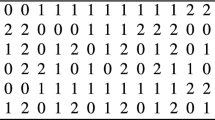Abstract
The notion of a detecting array (DTA) was proposed, recently, by Colbourn and McClary in their research on software interaction tests. Roughly speaking, testing with a (d, t)−DTA(N, k, v) can locate d interaction faults and detect whether there are more than d interaction faults. In this paper, we establish a general lower bound on sizes of DTAs and explore an equivalence between optimal DTAs and super-simple orthogonal arrays (OAs). Taking advantage of this equivalence, a great number of DTAs are constructed, which are all optimal in the sense of their sizes. In particular, an optimal (2, t)−DTA(N, 5, v) of strength t = 2 or 3 is shown to exist whenever v ≥ 3 excepting \({(t, v) \in \{(2, 3), (2, 6),(3, 4), (3, 6)\}}\) .
Similar content being viewed by others
References
Beth T., Jungnickel D., Lenz H.: Design Theory, 2nd edn. Cambridge University Press, Cambridge (1999)
Bush K.A.: Orthogonal arrays of index unity. Ann. Math. Stat. 23, 426–434 (1952)
Bush K.A.: A generalization of the theorem due to MacNeish. Ann. Math. Stat. 23, 293–295 (1952)
Colbourn C.J.: Combinatorial aspects of covering arrays. Le Matematiche (Catania) 58, 121–167 (2004)
Colbourn C.J.: Strength two covering arrays: existence tables and projection. Discrete Math. 308, 772–786 (2008)
Colbourn C.J., Dinitz J.H.: The CRC Handbook of Combinatorial Designs, 2nd edn. CRC Press, Boca Raton, FL (2007)
Colbourn C.J., McClary D.W.: Locating and detecting arrays for interaction faults. J. Comb. Optim. 15, 17–48 (2008)
Colbourn C.J., Martirosyan S.S., Mullen G.L., Shasha D.E., Sherwood G.B., Yucas J.L.: Products of mixed covering arrays of strength two. J. Combin. Des. 14, 124–138 (2006)
Hedayat A.S., Slone N.J.A., Stufken J.: Orthogonal Arrays. Springer, New York (1999)
Ji L., Yin J.: Constructions of new orthogonal arrays and covering arrays of strength three. J. Combin. Theory (A) 117, 236–247 (2010)
MacNeish H.F.: Euler squares. Ann. Math. NY 23, 221–227 (1922)
Martinez C., Moura L., Panario D., Stevens B.: Locating error using ELAs, covering arrays, and adaptive testing algorithms. SIAM J. Discrete Math. 23, 1776–1799 (2009)
Shi C., Tang Y., Yin J.: Optimal locating arrays for at most two faults (submitted).
Tang Y., Yin J.: Detecting arrays and optimality. Acta Math. Sin. (to appear).
Author information
Authors and Affiliations
Corresponding author
Additional information
Communicated by C. J. Colbourn
Rights and permissions
About this article
Cite this article
Shi, C., Tang, Y. & Yin, J. The equivalence between optimal detecting arrays and super-simple OAs. Des. Codes Cryptogr. 62, 131–142 (2012). https://doi.org/10.1007/s10623-011-9498-9
Received:
Revised:
Accepted:
Published:
Issue Date:
DOI: https://doi.org/10.1007/s10623-011-9498-9



